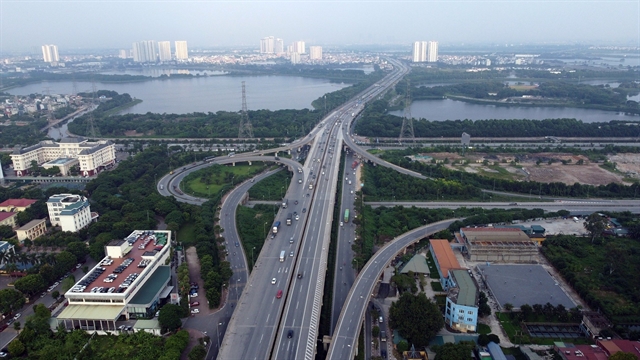 Opinion
Opinion

Nguyễn Mạnh Hà, vice chairman of the Housing and Real Estate Market Management Agency, speaks to Thời báo Kinh tế Việt Nam (Việt Nam Economic Times) about the pros and cons of building tiny flats in Việt Nam
 |
Nguyễn Mạnh Hà, vice chairman of the Housing and Real Estate Market Management Agency, speaks to Thời báo Kinh tế Việt Nam (Việt Nam Economic Times) about the pros and cons of building tiny flats in Việt Nam
Do you think that the Ministry of Construction’s decision to give a nod to the construction of an apartment of 25 square metres goes against the 2004 Housing Law?
Under the 2004 Housing Law, the minimum construction floor area for an affordable housing apartment shall be 30sq.m and that of a commercial housing apartment shall be 45sq.m. However, under the 2014 Housing Law, such specific regulations were abolished.
It now says “the standard area of each commercial residential house shall be decided by the project investor in conformity with the detailed construction zoning plan, construction standards and regulations, and the document approving the investment project. As such, the minimum area for each house type shall be decided by the investors themselves and not be regulated by the 2014 Housing Law.”
The Ministry of Construction (MOC) will soon issue a set of National Technical Standards for Residential Buildings. While waiting for that legal document, the MOC approves construction of apartments with a minimum area of 25sq.m. However, the MOC also states clearly that all the small apartments must be designed and constructed as standard self-contained apartments.
Many people are concerned this may result in the spread of slum residential areas. How do you respond to that?
I don’t think small flats are to be blamed for slum residential areas. As we all know, living conditions do not depend on the apartments people live in. They depend on the design of that urban area and its surrounding infrastructure. If 25sq.m flats are built in a big residential area like Vinhomes in Hà Nội, I’m pretty sure people living in these small flats will have better access to convenient facilities offered by the project owners than in areas which are quite far away from the city center.
Further more, the MOC has stated clearly that in a construction project’s proposal, the owner must specify clearly areas dedicated to each type of housing construction in specific percentage. According to experience from other countries, apartments are divided into four categories: studio, one bedroom; two bedrooms, three bedrooms or more. Of course, there are set standards for these apartments. For example, in Ha Noi’s Mỹ Đình area, a 45sq.m studio is designed to have only one room with a kitchen and a toilet. Meanwhile an apartment with one bed room has an area of 55sq.m while a two bedroom will have an area 75sq.m.
In the case of Australia, a minimum area of a studio is 30sq.m, while in South Korea it is less than 22. In other words, the rule varies from one country to another depending on their economic conditions. But the common standard in the world is that the number of studios in a construction project will be capped at 10 percent of the total project’s apartments; 20 percent are one-bedroom apartments; 50 percent are two-bedroom apartments; 20 percent are three-bedroom apartments.
However, under our law there is no rule on how many people can live in a studio. That’s why a few people share studios. This burdens the building infrastructure as well as urban management. Do you have any comments?
I should say there is no rule that an apartment with three or four bedrooms must have four people living in it. Sometimes only one person lives in that apartment and in other cases, only a couple lives in a villa covering 500sq.m. I should say that most families living in flats/apartment in Việt Nam have only three members. Quite a few have four members.
What I want to emphasise here is that we should do urban management in accordance with our laws, not someone else’s.
So do you think that we should have a specific law regulating that 26sq.m apartments must be built on the outskirts?
I object to that idea. Where they should be built depends on market demand not on the will of certain groups of people.
We are now living in a market economy. Many people prefer to live in a small flat with good facilities rather than living in a big flat with poor facilities. In other words, we cannot force investors to go to outlying districts to build small flats or to force people wanting to own small flats with good facilities to go to outlying districts to buy them. — VNS
Nguyễn Trí Dũng, deputy director of the Hà Nội Department of Construction:Hà Nội will not allow the construction of 25sq.m flats within the first and second ring roads or the core area of the city. In addition, the number of 25sq.m flats will depend on the location of the project. Phạm Sỹ Liêm, Vice Chairman of the Việt Nam Civil Engineering Association, is concerned that the construction of small flats in urban areas might cause problems for many urban areas in the country. He calls on authorities to pay special attention to their management so that small flats do not turn into slum areas. Lê Hoàng Châu, Chairman of the HCM City Real Estate Association, suggests that the construction of 25sq.m flats be prohibited in the inner districts of Hà Nội and HCM City. |


.jpg)






